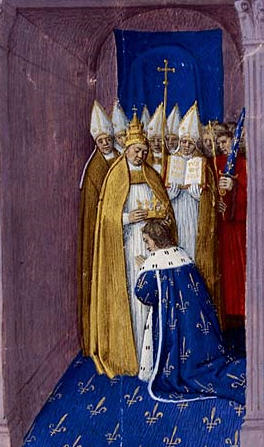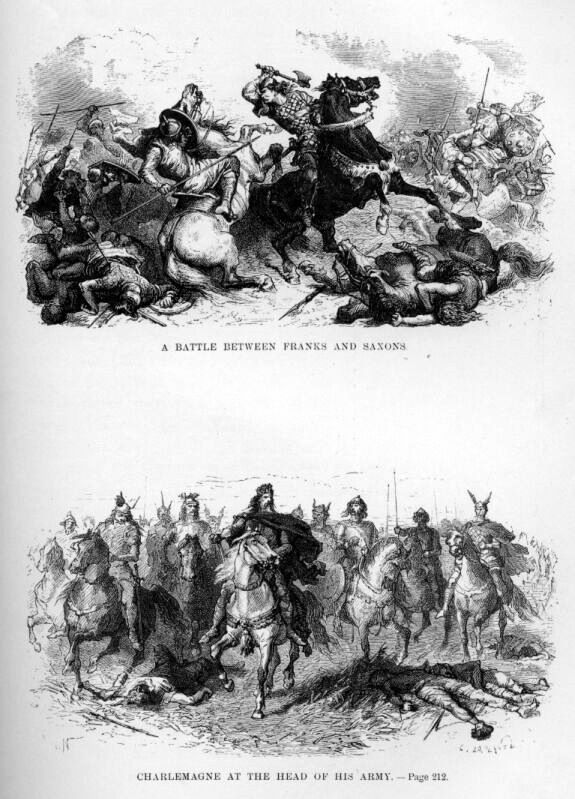|
Lüne
Lüne ( la, Hliuni) was a location on the left bank of the lower Elbe, known in connection with the Saxon war of 795. It was a village near Lüneburg. The Frankish king Charlemagne, intending to campaign against the Avars, summoned Saxon troops. Some Transelbean Saxons refused to heed the summons and Charlemagne marched into Saxony, encamping at Lüne while waiting for his Obodrite allies to join him. Some Saxons ambushed the Obodrite king Witzan as he was crossing the Elbe, killing him. A campaign of devastation was then waged against Saxony, culminating in the taking of hostages. This marks the beginning of a new phase in the Saxon wars, marked by economic devastation and deportations. While Charlemagne was still at Lüne, he was visited by envoys of the ''tudun'' of the Avar khaganate. According to the ''Royal Frankish Annals'' for 795: In this year the king came to Kostheim, a suburb of the city of Mainz, and there he held an assembly. When he heard that the Saxons had, as u ... [...More Info...] [...Related Items...] OR: [Wikipedia] [Google] [Baidu] |
Lüneburg
Lüneburg (officially the ''Hanseatic City of Lüneburg'', German: ''Hansestadt Lüneburg'', , Low German ''Lümborg'', Latin ''Luneburgum'' or ''Lunaburgum'', Old High German ''Luneburc'', Old Saxon ''Hliuni'', Polabian ''Glain''), also called Lunenburg ( ) in English, is a town in the German state of Lower Saxony. It is located about southeast of another Hanseatic city, Hamburg, and belongs to that city's wider metropolitan region. The capital of the district which bears its name, it is home to roughly 77,000 people. Lüneburg's urban area, which includes the surrounding communities of Adendorf, Bardowick, Barendorf and Reppenstedt, has a population of around 103,000. Lüneburg has been allowed to use the title " Hansestadt" (''Hanseatic Town'') in its name since 2007, in recognition of its membership in the former Hanseatic League. Lüneburg is also home to Leuphana University. History ImageSize = width:1050 height:100 PlotArea = width:1000 height:50 left:50 bottom ... [...More Info...] [...Related Items...] OR: [Wikipedia] [Google] [Baidu] |
Heimrich, Count In The Upper Rheingau
Heimrich (Heimo) (740-5 May 795), Count in the Upper Rheingau (Oberrheingau), son of Cancor, Count of Hesbaye, and Angila. Heinrich was also Count of Lahngau, and lay abbot of Mosbach Abbey. Heimrich was a leader in the forces of Charlemagne in his prosecution of the Saxon Wars and was killed in the Battle of Lüne and the Elbe fighting the Obotrite Slavs. Heinrich married Eggiwiz of an unknown family. They had two children: * Heimrich (765-812), Count of Saalgau * Bubo of Grabfeldgau (763-795) Heimrich was the grandfather of Poppo of Grapfeld through his son and namesake, and therefore an early member of the House of Babenberg The House of Babenberg was a noble dynasty of Austrian Dukes and Margraves. Originally from Bamberg in the Duchy of Franconia (present-day Bavaria), the Babenbergs ruled the imperial Margraviate of Austria from its creation in 976 AD until its .... Sources * Reuter, Timothy (trans.), ''The Annals of Fulda, Manchester Medieval series, Ninth-Cen ... [...More Info...] [...Related Items...] OR: [Wikipedia] [Google] [Baidu] |
Elbe
The Elbe (; cs, Labe ; nds, Ilv or ''Elv''; Upper and dsb, Łobjo) is one of the major rivers of Central Europe. It rises in the Giant Mountains of the northern Czech Republic before traversing much of Bohemia (western half of the Czech Republic), then Germany and flowing into the North Sea at Cuxhaven, northwest of Hamburg. Its total length is . The Elbe's major tributaries include the rivers Vltava, Saale, Havel, Mulde, Schwarze Elster, and Ohře. The Elbe river basin, comprising the Elbe and its tributaries, has a catchment area of , the twelfth largest in Europe. The basin spans four countries, however it lies almost entirely just in two of them, Germany (65.5%) and the Czech Republic (33.7%, covering about two thirds of the state's territory). Marginally, the basin stretches also to Austria (0.6%) and Poland (0.2%). The Elbe catchment area is inhabited by 24.4 million people, the biggest cities within are Berlin, Hamburg, Prague, Dresden and Leipzig. Etymology Firs ... [...More Info...] [...Related Items...] OR: [Wikipedia] [Google] [Baidu] |
Tudun
A tudun was a governor resident in a town or other settlement in the ancient Bulgar, Avar or Gokturk empires, particularly those of the Bulgars and the Khazars. The tudun was the personal representative of the imperial government and could function both as an administrator and a diplomat. At times, a tudun would be appointed for a town nominally under another power's control but ''de facto'' within the sphere of influence of the tudun's khagan Khagan or Qaghan (Mongolian:; or ''Khagan''; otk, 𐰴𐰍𐰣 ), or , tr, Kağan or ; ug, قاغان, Qaghan, Mongolian Script: ; or ; fa, خاقان ''Khāqān'', alternatively spelled Kağan, Kagan, Khaghan, Kaghan, Khakan, Khakhan .... History of the Turkic peoples Khazar titles Titles of the Göktürks {{CAsia-hist-stub ... [...More Info...] [...Related Items...] OR: [Wikipedia] [Google] [Baidu] |
Old Saxony
"Old Saxony" is the original homeland of the Saxons. It corresponds roughly to the modern German states of Lower Saxony, eastern part of modern North Rhine-Westphalia state (Westphalia), Nordalbingia (Holstein, southern part of Schleswig-Holstein) and western Saxony-Anhalt (Eastphalia), which all lie in northwestern Germany. It had four provinces: Nordalbingia, Eastphalia, Westphalia and Angria or Angaria, these provinces, in turn, were divided into smaller territories, the gaue, which are equivalent to modern Districts of Germany (''Kreise''), and were equivalent to the English shires (modern counties). It should not be confused with the modern German state of Saxony, which is in eastern Germany, adjoining the northwest border of the Czech Republic. Origin and history Tacitus in his 1st century work ''De Origine et situ Germanorum'' ascribes several tribes of Germanic peoples inhabiting the northern seaboard and interior lands later called ''Old Saxony'', viz; ''(English tra ... [...More Info...] [...Related Items...] OR: [Wikipedia] [Google] [Baidu] |
790s Conflicts
{{Numberdis ...
79 may refer to: * 79 (number) * one of the years 79 BC, AD 79, 1979, 2079 * ''79 A.D.'', a 1962 historical epic film * Eruption of Mount Vesuvius in 79, a catastrophic volcanic eruption in Italy See also * * List of highways numbered A ''list'' is any set of items in a row. List or lists may also refer to: People * List (surname) Organizations * List College, an undergraduate division of the Jewish Theological Seminary of America * SC Germania List, German rugby union ... [...More Info...] [...Related Items...] OR: [Wikipedia] [Google] [Baidu] |
Hervé Pinoteau
Baron Hervé Pinoteau (19 July 1927 – 24 November 2020) was a French historian and royalist apologist. He was the author of more than 900 articles and 22 books primarily on history and heraldry. Biography Pinoteau was born in Paris. From 1950 to 1951, he served in the French army as a lieutenant. He served as the private secretary of the late Prince Alphonse, Duke of Anjou, for 26 years. Pinoteau was a member of the Académie Internationale d'Héraldique (International Academy of Heraldry) of which he was general secretary from 1964 to 1988. He was president of the Société nationale des Antiquaires de France in 2010. He was recognized as an expert in French heraldry and vexillology. He was commissioned to create the coat of arms of the Pays de la Loire region of France, and to do the final design for the coat of arms of the Republic of Chad. Pinoteau was a monarchist who believed in the restoration of the House of Bourbon to the French throne. He was the founder of the Secre ... [...More Info...] [...Related Items...] OR: [Wikipedia] [Google] [Baidu] |
Royal Frankish Annals
The ''Royal Frankish Annals'' (Latin: ''Annales regni Francorum''), also called the ''Annales Laurissenses maiores'' ('Greater Lorsch Annals'), are a series of annals composed in Latin in the Carolingian Francia, recording year-by-year the state of the monarchy from 741 (the death of Charles Martel) to 829 (the beginning of the crisis of Louis the Pious). Their authorship is unknown, though Wilhelm von Giesebrecht suggested that Arno of Salzburg was the author of an early section surviving in the copy at Lorsch Abbey. The Annals are believed to have been composed in successive sections by different authors, and then compiled. The depth of knowledge regarding court affairs suggests that the annals were written by persons close to the king, and their initial reluctance to comment on Frankish defeats betrays an official design for use as Carolingian propaganda. Though the information contained within is heavily influenced by authorial intent in favor of the Franks, the annals remai ... [...More Info...] [...Related Items...] OR: [Wikipedia] [Google] [Baidu] |
Witzan
Witzan (died in 795 in Liuni) also known by name ''Witzan'' was prince of the confederation of Obotrites. As an ally of Charlemagne in his war against Saxons Witzan marched his army against Magdeburg in 782 and destroyed it completely. This provoked war with nearby Slavic nation of Wiltzi (Veléti). In the war Obotrites allied with Franks, Sorbs, Frisians fought against Wiltzi and Danes. After restoration of Saxon rebellion Witzan marched again against them and was killed in ambush by Saxons The Saxons ( la, Saxones, german: Sachsen, ang, Seaxan, osx, Sahson, nds, Sassen, nl, Saksen) were a group of Germanic * * * * peoples whose name was given in the early Middle Ages to a large country (Old Saxony, la, Saxonia) near the Nor ... in Liuni. Bibliography * Labuda G., ''Wican'' :''Słownik Starożytności Słowiańskich'', t. VI, Wrocław 1980, (całość), p. 415 {{DEFAULTSORT:Witzlaus Of Obotrites 8th-century Slavs 795 deaths Obotrite princes Year of bi ... [...More Info...] [...Related Items...] OR: [Wikipedia] [Google] [Baidu] |
Saxon Wars
The Saxon Wars were the campaigns and insurrections of the thirty-three years from 772, when Charlemagne first entered Saxony with the intent to conquer, to 804, when the last rebellion of tribesmen was defeated. In all, 18 campaigns were fought, primarily in what is now northern Germany. They resulted in the incorporation of Saxony into the Frankish realm and their forcible conversion from Germanic paganism to Christianity. The Saxons were divided into four subgroups in four regions. Nearest to the ancient Frankish kingdom of Austrasia was Westphalia, and farthest was Eastphalia. In between the two kingdoms was that of Engria (or Engern), and north of the three, at the base of the Jutland peninsula, was Nordalbingia. Despite repeated setbacks, the Saxons resisted steadfastly, returning to raid Charlemagne's domains as soon as he turned his attention elsewhere. Their main leader, Widukind, was a resilient and resourceful opponent, but eventually was defeated and baptized (in 785 ... [...More Info...] [...Related Items...] OR: [Wikipedia] [Google] [Baidu] |
Obodrite
The Obotrites ( la, Obotriti, Abodritorum, Abodritos…) or Obodrites, also spelled Abodrites (german: Abodriten), were a confederation of medieval West Slavic tribes within the territory of modern Mecklenburg and Holstein in northern Germany (see Polabian Slavs). For decades, they were allies of Charlemagne in his wars against the Germanic Saxons and the Slavic Veleti. The Obotrites under Prince Thrasco defeated the Saxons in the Battle of Bornhöved (798). The still heathen Saxons were dispersed by the emperor, and the part of their former land in Holstein north of Elbe was awarded to the Obotrites in 804, as a reward for their victory. This however was soon reverted through an invasion of the Danes. The Obotrite regnal style was abolished in 1167, when Pribislav was restored to power by Duke Henry the Lion, as Prince of Mecklenburg, thereby founding the German House of Mecklenburg. Obotritic confederation The Bavarian Geographer, an anonymous medieval document compiled in R ... [...More Info...] [...Related Items...] OR: [Wikipedia] [Google] [Baidu] |



